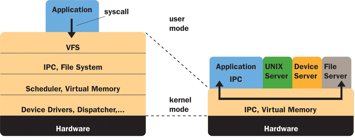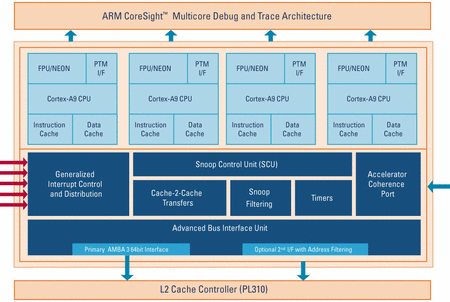Microkernel OS spins ARM Cortex support
Dec 15, 2008 — by LinuxDevices Staff — from the LinuxDevices Archive — 21 viewsOpen Kernel Labs (OK Labs) announced that its microkernel for processor virtualization will support devices using ARM Cortex-A8 and Cortex-A9 MP Core multi-core CPUs. The OKL4 microkernel's multi-core support might allow Linux to co-exist on Cortex-A8 and -A9 processors with Windows Mobile or other legacy RTOSes (real-time operating systems).
OKL4 is a microkernel OS that runs almost everything in userspace. The OS includes a thin hardware abstraction layer that can support Linux, Windows Mobile, Windows CE, Symbian, and/or other guest OSes. It also includes a minimal POSIX-compliant execution environment, enabling multiple applications and drivers to run in separate, isolated partitions, OK Labs says.

OKL4 Architecture
In 2007, OK Labs announced a port of OKL 4 to ARMv6. In April of this year, version 2.0 was announced, adding a “Secure HyperCell” technology (below) aimed at encapsulating and protecting critical software components from the rest of the system.

OKL4 version 2.0 Secure Hypercell architecture
(Click to enlarge)
In October, version 3.0 made its debut, adding an improved SDK (software development kit), plus a new memory usage tool that is said to ease development by mapping both physical and virtual memory.
Now, OK Labs says OKL4 will support advanced mobile chipsets built on ARM's Cortex-A8 and Cortex-A9, the latter sporting up to four cores. Targeted uses include asymmetric multicore systems with processors dedicated to different processing functions. Another goal is to enable the migration of non-SMP-capable OSes such as Windows CE and Windows Mobile to dual, tri- and quad-core mobile CPUs, the company says.
Though no further specifics were provided, the company's claims apparently mean that existing Windows Mobile and Windows CE operating systems and applications would be able to tap into the power of multiple cores, without any alternations. This would take place thanks to the OK Labs microkernel, capable of making multiple CPUs appear to OSes as a single virtual processor.
Steve Subar, CEO of OK Labs, said, “Not so long ago, multicore processors were only found in high-end data center hardware,” noted “Multicore CPUs are now mainstream in the data center and on the desktop, and are rapidly making inroads into mobile/wireless device design.”
Background
The Cortex-A8, first announced in October 2005, has a superscalar architecture theoretically capable of dispatching two to three times more instructions per cycle than ARM11, while power consumption is no greater, claims ARM. Earlier this year, Texas Instruments (TI) launched a bevy of Cortex-A8 processors, including the OMAP 3440, aimed at mobile phones, and the OMAP 35xx, which is said to target “Internet appliances” and PMPs (portable media players). The top model in the latter family, the OMAP 3530, is said to decode HD video at 30 frames per second, and also sports an OpenGL ES 2.0 graphics accelerator, TI says.

ARM Cortex A9 in MPCore configuration
(Click to enlarge)
In 2007, ARM announced the multicore-enabled Cortex-A9, which, thanks to MPCore interconnect technology (above), is claimed to support SoC (system-on-chip) designs with up to four A9 cores. The Cortex-A9 will offer clock speeds over 1GHz, and will provide “four to 16 times the performance” of ARM11 while still fitting within the same power envelope, says ARM.
While ARM processors are generally associated with mobile phones, the Cortex-A8 and Cortex-A9 are also headed for netbooks, according to comments made by a senior ARM executive in October. OK Labs's software will allow these netbooks to run Linux, Windows Mobile, and other ARM-compatible operating systems simultaneously, but will not support x86-specific OSes such as Windows XP or Windows Vista.
Meanwhile, OK Labs claims OKL4 provides an extremely small “trusted security base” for services that would be impossible or impractical to implement outside the kernel. Crypto services, for example, can be designed to use less than 20,000 lines of system code, thereby helping to improve performance and reduce opportunities for security threats, the company claims. Graphical native OKL4 applications are even possible, thanks to a lightweight graphics stack called Fluffy Spider FancyPants.
Running each OS personality in a separate user space partition is said to enable license segregation and protection, as well as protection from software faults. In other words, an OS crash in userspace may not crash the whole system. For example, a mobile phone could still place a call if the OS crashed while editing a photo or the like. Yet another touted benefit is that the OS segregation enabled by virtualization could enable GPL-licensed software to co-exist with closed software, such as software-defined radio basebands, on the same processor.
Availability
Version 3.0 of the OKL4 microkernel is available now, and can be downloaded here, under either an open source or commercial use license. No further details on the planned ARM Cortex support were provided, however.
This article was originally published on LinuxDevices.com and has been donated to the open source community by QuinStreet Inc. Please visit LinuxToday.com for up-to-date news and articles about Linux and open source.